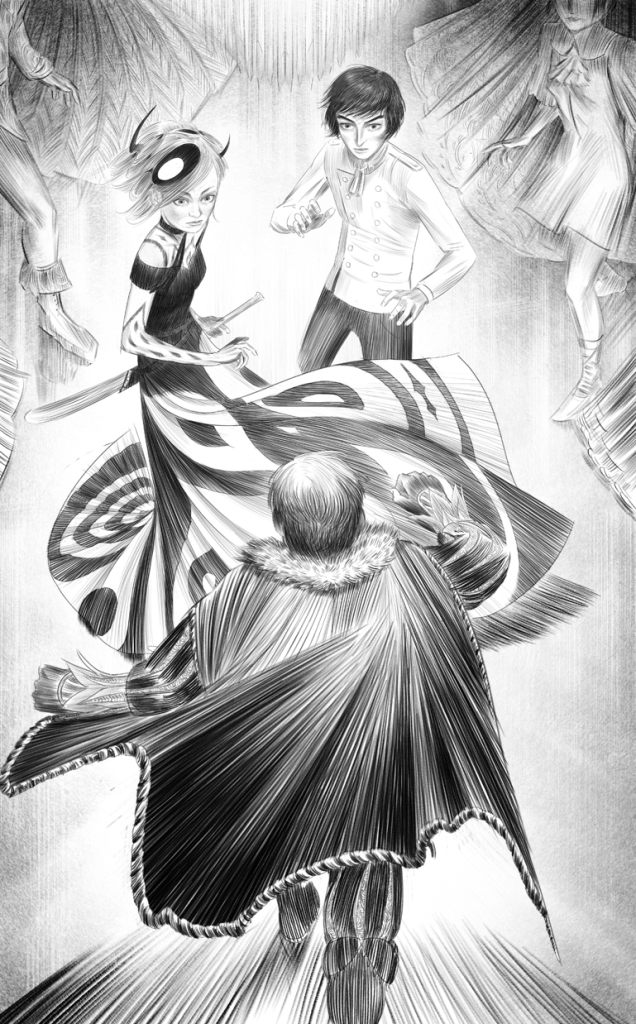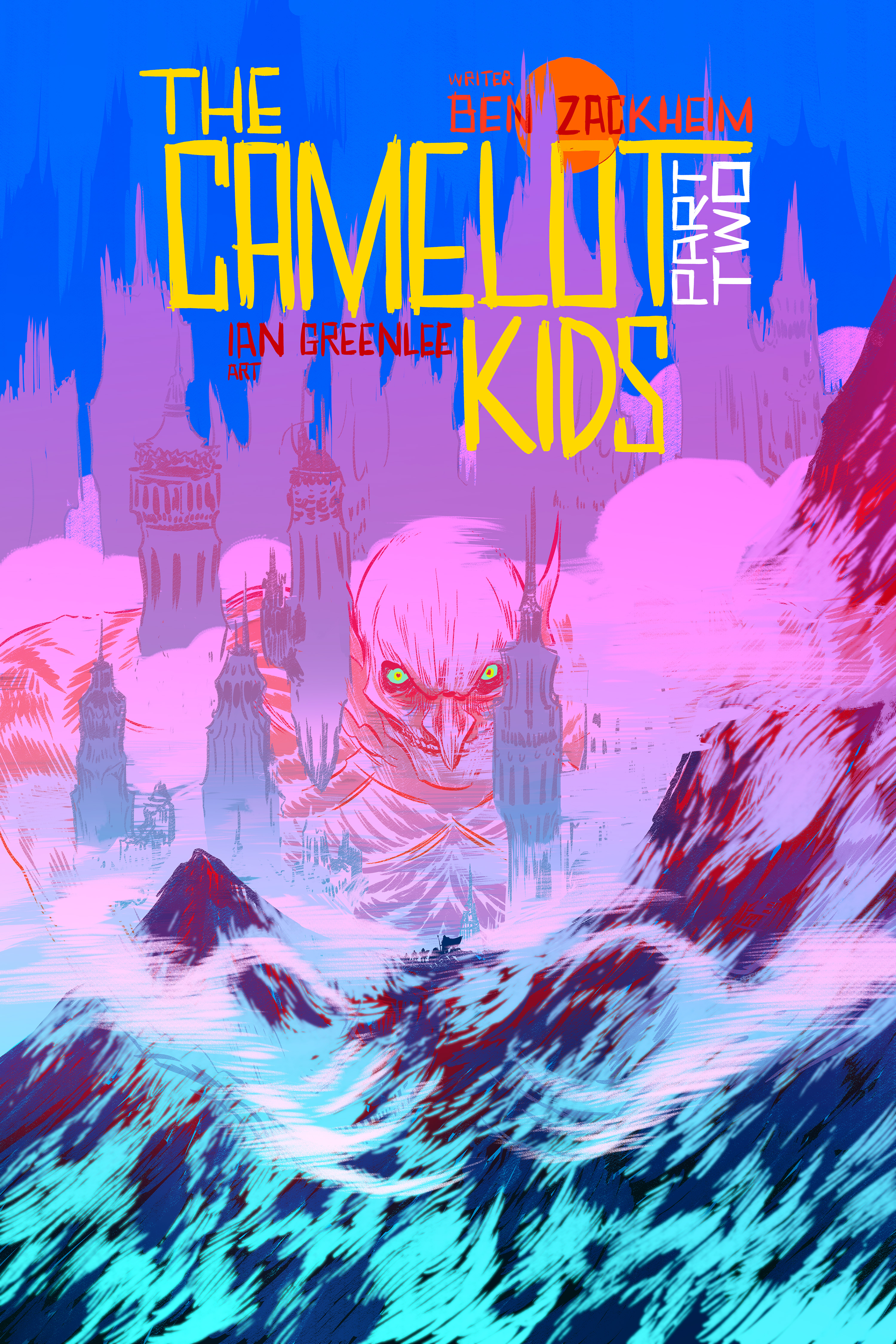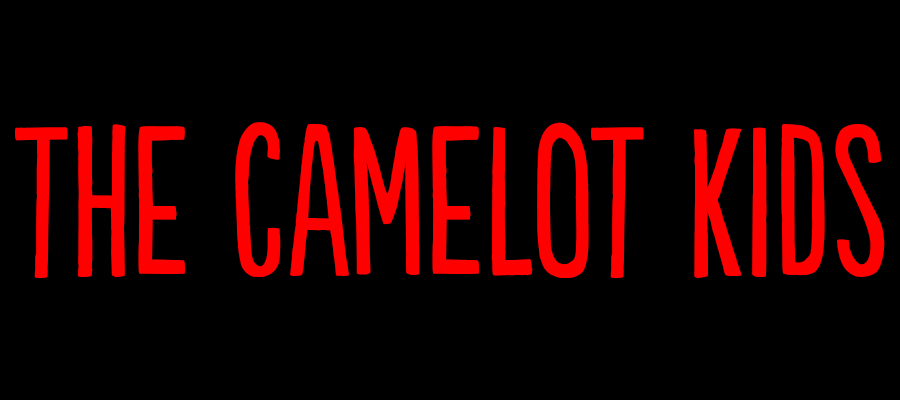by Ben Zackheim | Oct 13, 2014 | The Camelot Kids |
Here’s a beautiful illustration of The Ball scene in The Camelot Kids: Part Two. Ian Greenlee went all out on that dress! The scene captures a moment where the heir to King Arthur’s throne shows up. I won’t give anything away, but it’s someone Simon knows (as you can see on the expression his face is wearing).
And, um, why is the guy charging Simon like that?

The Ball by Ian Greenlee for The Camelot Kids

by Ben Zackheim | Oct 10, 2014 | The Camelot Kids |
 Head on over to Amazon to grab The Camelot Kids: Part Two
Head on over to Amazon to grab The Camelot Kids: Part Two for $1! I’m so proud of this one. It took a little longer to release than we’d hoped, but I hope you’ll agree that it was worth the wait.
for $1! I’m so proud of this one. It took a little longer to release than we’d hoped, but I hope you’ll agree that it was worth the wait.
The Camelot Kids: Part Two is the next chapter in the Fantasy series readers are calling, “a thoroughly modern and thoroughly fun new take on the legends of Camelot!”
Simon Sharp just got kidnapped by a troll on the shore of Scotland’s Loch Duich. But before he can get his head around that incredible fact, he’s saved by a 7-foot tall elderly man who calls himself Merlin. It’s hard to deny that something odd is going on.
But what?
Join Simon as he takes his first steps into New Camelot, a castle city of unparalleled beauty. But his stay won’t always be a pleasant one as he trains to become a warrior side-by-side with 149 other kids… all descendants of the original Knights of the Round Table.
The Camelot Kids: Part Two answers many questions from Part One, and adds a few more that will keep you guessing until the end!
If you missed the first installment of The Camelot Kids, pick up The Camelot Kids: Part One for a buck, exclusively on Amazon.com!

by Ben Zackheim | Sep 12, 2014 | The Camelot Kids, Writing |
Chivalry is the act of defending those who cannot defend themselves.
That’s a simplification, but I’m going with it (for now), and you can’t stop me.
The same way magic is the code that holds Harry Potter’s world together, chivalry is the code, the foundation and the social dynamic of Camelot.
Now that I’ve completed Book One, I understand that something in the core of the mythology was drawing my own sense of chivalry out of me. It was injecting these complex, flawed characters with a sense of doing the right thing, no matter the cost. Sure, the complex moments of bravery, stubbornness and kindness were emerging in a mystery/action/adventure yarn. But within the mask of story was a seed of humanity that I’d never considered deeply for my protagonists before.
An orphan helps an orphan.
A bullied student helps the new kid escape a gang.
Even those who live a life rife with heartache and hard knocks emerge chivalrous. No, especially those who live a life rife with heartache and hard knocks emerge chivalrous.
But why? How? Where does this instinct to protect those around us come from? What happens inside us when we drop our own interests and risk everything for other people?
The answer became clear as I wrote the book.
The dynamic of wanting to connect with people is the same dynamic that makes us risk everything to help them. In other words, our connection to each other, simply because we’re human, has costs as well as payoffs. For our humanity, we get friendship, love and support as a “payoff”. But does that mean that heartbreak, pain and rejection are the “cost”?
No. That was my revelation as I wrote The Camelot Kids.

The cost of this human experience isn’t heartache, pain and rejection. It’s chivalry.
Being loved, supported, hated, ignored creates an astonishing power to do the right thing for anyone — friend, foe, or stranger. That human connection is so complex that something in us is willing to give our lives for it in a split second.
For me, this revelation does something profound to my sense of modern life. Don’t we live in an insulated bubble? I’ve assumed that most of us reach a certain age of reason where we construct a world with as much love as possible, and avoid the most pain. It takes a while, but it seems to me to be a standard human thing to do. To the degree that we have control over our surroundings, don’t the vast majority of us expend a tremendous amount of energy on building comfort and avoiding discomfort?
While I still think the answer to these questions is yes, it’s clear that we have a Trojan horse of bravery, duty, kindness and chivalry in us. It’s rolled into our gut at around the same time we look at another human and realize we want to keep them close forever. And it’s solidified when we meet our first enemy.
I think it’s the most exquisite insight we could have today. I think mythology that reinforces this inherent power in each of us is what we all need right now.
Taking this idea further; our disillusionment with Arthurian lore is indicative of our disconnect with our own chivalry.
Prove it!
Okay. When was the last time we felt connected to the second most famous myth of our time? We get chance after chance in the Merlin or Camelot TV shows, the recent King Arthur movie — but they don’t resonate outside a small group of fans. It’s not because the efforts suck, necessarily (though some do). It’s that they’re stale. They treat chivalry like it’s a noble thing only, and not the complex force it is.
Chivalry is Gandhi.
Chivalry is Martin Luther King, Jr.
Chivalry is Malala Yousafzai.
The heroes of Camelot don’t need to tell the same thousand year story again.
The heroes need to be among us. More importantly, they need to be chivalrous among us.
So for all my humility and fear in tackling the lauded lore, my goal with my new book, The Camelot Kids, is to give the world a peek into Camelot in our time. I want to make Camelot fun again. And I want to do it in a way that’s respectful of the tales’ whimsy, boldness and deep conviction that to do right for others is to do right for everyone, including yourself.
After all, the more in touch we are with our inner Camelot, our sense of chivalry, the better off the world will be.

by Ben Zackheim | Aug 6, 2014 | Writing |

(You can now buy Part One of The Camelot Kids on Amazon.)
When I first had the idea for The Camelot Kids, my upcoming book, it was about a summer camp run by Merlin.
Cool idea, maybe, but too similar to some stories I was reading at the time. I abandoned the project before it got started.
But my brain snagged on the Camelot myth. Knights, dragons, wizards, adventure, love, betrayal; this is the stuff we scarf up like Reese’s Peanut Butter Cups these days. And it’s attributable, or at least natural, to King Arthur in one way or another. Camelot and King Arthur are the vehicle in which Fantasy (with a capital ‘F’) has been carried through time, to our time.
If you ask people to tell the story of Camelot, well, that could mean a bunch of things.
The quest for the Holy Grail!
The forbidden, dangerous love affair between Queen Guinivere and the knight Lancelot!
Arthur pulling the sword from the stone!
Whichever tale you associate with the Camelot myth, it’s in your noggin somewhere, and it’s a good bet that your impression is somewhere between “blech” and “meh.”
Isn’t that odd? One of the heartiest yarns to survive the ages actually leaves many Fantasy fans cold!
As I dug into the story I found something even odder. Camelot felt like a cardboard cutout of fantasy. It felt like a 50s Disney film with pointy towers and pointy flags and fair ladies with pointy hats. Everyone wore white or gleaming armor in my mind’s eye. Fair maidens batted their eyelashes. And knights? They jousted, or something. Blech, indeed. Maybe Camelot wasn’t for me after all.
But there’s a big but.
I figured out how Camelot would be relevant to me again. It wasn’t easy. In fact, it took Alice in Wonderland, Narnia, Harry Potter and, most importantly, the horrible 80s film, He-Man and the Masters of the Universe to give me my eureka moment.

The world sucked for a kid growing up in 70s and 80s America.
And it was hard to ignore the suckage, which ranged from the Iran Hostage Crisis to Max Headroom to everything else.
Luckily, Fantasy was thriving ! Star Wars, comics, and any Atari game or Tor book were crucial to my sanity. Taking a look around at what popular culture has become today, it’s clear that several billion others felt the same way.
Back then, I read comics and books that swept me away from wherever I was because wherever I was just plain bit. With Star Wars or Superman I could escape into a place that had nothing in common with my farty classroom, or the stale mall, or my quiet bedroom. To me, there was no magic here. There was only magic there.
This is one of the reasons why I hated stories where kids from our world stepped into another one. To me, even one child from our reality stepping into a fantastic world would be like a cancer on the story, sucking our insecurities about “otherness” out of us like pus from a wound. Narnia, Wizard of Oz, Alice in Wonderland…they were so quaint with their talking animals and spritzy, cute sheen. (note: I love them now, but I was an angry teen!)
Worst of all? The kids always wanted to go home! Losers.
The people in these stories were shallow to me. Their bonds to other characters were like a person to a pet — strong but inhuman. All the “heroes” had one foot out the door, willing to risk everything to see mommy again.
My hatred of the “Looking Glass” type of story was vindicated (in my petty mind) when the He-Man and the Masters of the Universe movie came out in 1987. Starring Dolph Lundgren and Courtney Cox — need I say more? In the movie, He-Man is trapped in our universe in a far-from-epic adventure designed to sap the magic out of our world for decades. No, that wasn’t the plot. That’s what the movie actually did. It made your standard TV movie of the week look like The Godfather. To me, this movie was proof that no one knew how to take a normal kid, place him in another world and tell a good story.
I balanced myself on that told-you-so soapbox for years. It was an argument I had with my film geek college friends in NYU Tisch School. I watched as Hollywood botched fantasy film after fantasy film with nary a lesson learned.

Then Harry Potter came along.
It took Harry Potter to show me that our world and a fantasy world could mix, and be fantastic. The thing about Harry Potter that changed the dynamic for me was emotion. The best Fantasy starts with our sense of love, jealousy, revenge, ambition and then places it in a fairy tale. What had been missing for years (for me) was a story that took place in our world but treated us as magic. What author would be daring enough to shed the sarcasm, the cynicism of our times and insist that adventure is right under our noses? Who would find a fantastic way to tell a human story where a school, not a parent, is the ultimate shield from harm? Who would acknowledge our deep desire to be swept into another world and never see this one again? It turned out to be JK Rowling.
The lore of King Arthur is stale because the humanity has been leeched out by centuries of interpretation. Characters have become cardboard caricatures. Camelot has become Disneyland. Chivalry has become trite. In many ways the second most recognizable fairy tale in the western world suffers a lack of depth.
This is what I thought. Past tense. Until…
(and this is where my desire to write about Merlin and his pawns sat up from its death bed like the Frankenstein monster)
…until you ponder the famous Arthurian characters as normal people trying to make the world a better place, but stumbling on their weaknesses.
That would be cool.
And make them modern people, who we can identify with.
But don’t lose the history. Never lose the history. Make a sequel, not an adaptation.
Writing is hard.
Writing about famous figures is harder.
Writing about Camelot is downright dangerous. The consequences of taking creative license with something that has Ivy League programs dedicated to it invites wrath that’s usually reserved for atheists writing about God. But, really, can you think of a more exciting hill to climb?
When I started researching The Camelot Kids, I’d never read any of the classic Arthurian tomes. I’d never seen the racy Excalibur flick or Disney’s Sword in the Stone. But somewhere along the line I’d become so familiar with the gist of the key characters that I spontaneously grew an appetite to consume their stories, old and new.
As I immersed myself in the myth of Arthur and his Knights of the Round Table I was struck by how familiar it was. When I read A Connecticut Yankee in King Arthur’s Court, I was surprised to find that it was good to see these old stalwarts, these staples of Fantasy. It wasn’t quite the same as seeing a new Indiana Jones movie, or picking up a new Harry Potter, but it was still a tug at the heart which is the sole domain for old favorites. Where did I ingest the story so deeply that I could tell you about Mordred or Morgan Le Fay? How could I recall the young Arthur pulling the sword from the stone? Why was Lancelot so burned into my mind’s eye?
My best answer is that all archetypes seep in. They’re in images we see every day. Their morals come up for air in the small deeds we do for and against others. They are us. And we are them.
So, upon realizing my love of characters whom I sensed, but did not know very well, I began work on The Camelot Kids.
From the blank page I noticed something odd.
It usually takes a while for me to flesh out my plot and characters. Weeks, months. But within days, I’d settled on writing a modern tale where a number of young teens are told that they’re descendants of Arthur and the Knights of the Round Table. Merlin needs their help to save New Camelot from destruction.
From the first tap of a keyboard key, the boys and girls in my new story came alive. They were sweet, petty, funny, confused, and searching for chances to connect with each other in meaningful ways.
And they were chivalrous. Naturally so. Humanly so. In other words, they were chivalrous at times, vindictive in others.
There’s that word again. Chivalrous. What is it? And why is it so important in King Arthur’s world? Here’s why!

[divider divider_type=”gradient”][/divider]
by Ben Zackheim | May 28, 2014 | Book Promotion, Sell your book |

What are keywords? They’re the words you use to describe your book. Sometimes you’ll hear them called keyword phrases, but that just means keywords that are more than one word long. For example, “hero” is a keyword and “android hero” is a keyword phrase.
Amazon asks for keywords.
BN.com asks for keywords.
In fact, every site with media wants them.
But why is it so important to find keywords for your book?
Keywords are a primary way for a store to understand what your book is about. When you give your book a keyword, you’re giving it an identity. After all, “detective” paints a different picture in your head than “cooking.” Keywords are beacons, pings, scents that get picked up by search engines, recommendation bots and, oh yeah… readers.
Keywords are like perfume. If chosen wisely, they make your book more attractive to the right folks. The kind of folks who are so totally into you (and your book).
So how do you find keywords to use for your book?
How do you find keywords that will help your book get visible on the online stores?
1) Be specific and be honest.
Use words that truly describe your book, not what you think will be popular.
And when you choose the keywords, use specific terms like “android hero” instead of “hero”. This will help the book get spotted by folks with specific tastes.
2) String a couple of words together to make a short, clear phrase.
So use “mystery series for kids 9-12” instead of just “kids mystery”. These keyword terms will map well with what customers actually type into the search bar when they’re looking for a book.
Use keywords in the same way a customer would use them. Example: sleuth mysteries, not mysteries sleuth
3) Test your keywords.
Go to the online bookstores where you sell your book.
Type in one of the words you chose for your book. Notice the window that drops down?

Those are suggestions for readers to make their search easier. But it’s also list of suggestions for authors trying to find keywords for their book!
Here’s how.
Scan the list of terms in that drop-down menu. Click on the first one that truly applies to your book. Do you like the results you see for that term? Do those books look like your competition? Then use that term! It applies to your book and it’s popular enough to appear in the drop-down menu — so go for it.
4) On Amazon, be sure to use all seven keywords or short phrases.
Separate them by a comma.
5) Be sure to use your keywords in the book metadata AND in the book description.
If the scent fits, then wear it everywhere! The more you use appropriate keywords on your book’s sales page, the better your chances of connecting to the right customer.
Keep these five tips in mind while you’re prepping your book for sale. You can also follow these tips if you want to find keywords for your existing books. I’ve seen Shirley Link & The Safe Case climb up two popular lists on Amazon just by tweaking the keywords after launch.
Good luck! It can be tough to find keywords for your book that work well. But as Amazon says, “To increase your book’s discoverability on Amazon, you need descriptions and keywords that accurately portray your book’s content and use the words customers will use when they search. Along with factors like sales history and Amazon Best Sellers Rank, relevant keywords can boost your placement in search results on Amazon.com. ”
You can’t be everything to everybody. That’s a recipe for failure. So choose your scent and find your book lovers!
Other writer’s advice on how to find keywords for books:
KDP Forum Post
Lindsay Buroker
The Metanautics Department (some interesting thoughts on using Google’s keyword tool to recognize term popularity in the general population)
By Ben Zackheim
You might also like:
How to write an author bio that sells books
Choose the best genre for your book on Amazon












